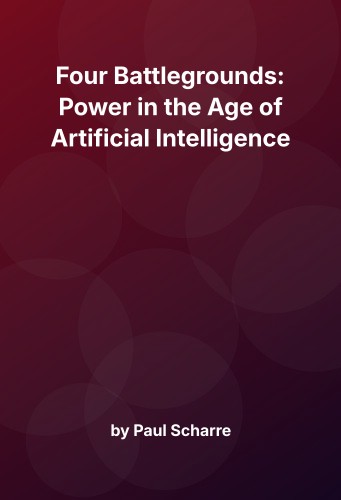Navigating the Modern Business Landscape: Strategic Insights from “Four Battlegrounds”
Introduction to Strategic Transformation
In “Four Battlegrounds,” Paul Scharre offers a critical exploration of the strategic challenges and opportunities defining the modern business environment, particularly through the lens of artificial intelligence (AI) and digital transformation. Scharre’s work provides a guide for professionals navigating the complexities of digital evolution, leadership, and business strategy, emphasizing the importance of agility and innovation in today’s rapidly changing landscape.
Embracing Digital Transformation
Digital transformation is central to Scharre’s narrative, underscoring the necessity for businesses to adapt to technological advancements. This section delves into strategic frameworks that organizations can adopt to harness the power of digital tools effectively. Scharre draws parallels with Eric Ries’ “The Lean Startup,” emphasizing iterative development and agile methodologies as essential components of thriving in a digital age.
Digital transformation is not merely a technological upgrade but a fundamental shift in organizational culture. This involves fostering a mindset of continuous learning and experimentation, akin to the principles of design thinking. For instance, similar to the themes in “The Innovator’s Dilemma” by Clayton Christensen, businesses need to disrupt their own processes to remain competitive. By embracing these concepts, organizations can become more responsive to market changes and customer needs.
Leadership in the Age of Innovation
Leadership plays a pivotal role in steering organizations through modern business complexities. Scharre outlines key leadership qualities essential for success in an era characterized by rapid change, including adaptability, vision, and the ability to inspire and motivate teams.
Drawing inspiration from Jim Collins’ “Good to Great,” Scharre highlights the cultivation of Level 5 Leadership, where humility and professional will are paramount. Leaders must adeptly navigate ambiguity and uncertainty, fostering a culture where innovation can thrive. This involves empowering employees to take risks and learn from failures, creating an environment conducive to resilience and growth.
Strategic Frameworks for Business Success
Scharre introduces several strategic frameworks that professionals can leverage to enhance business performance. One such model is the “Four Battlegrounds” framework, which identifies key areas where organizations must excel to achieve sustainable success. These include:
-
Customer Centricity: Understanding and anticipating customer needs is crucial for developing products and services that resonate with the market. Scharre advocates for a customer-first approach, drawing parallels with Clayton Christensen’s “Jobs to be Done” theory, emphasizing the necessity of aligning product development with customer needs.
-
Operational Excellence: Efficiency and effectiveness in operations are vital for maintaining a competitive edge. Scharre discusses the importance of process optimization and lean management techniques, echoing the principles outlined in “The Toyota Way” by Jeffrey Liker. This involves adopting continuous improvement processes and waste reduction strategies.
-
Innovation and Agility: The ability to innovate and adapt quickly is a defining characteristic of successful organizations. Scharre highlights the significance of fostering a culture of creativity and experimentation, akin to the innovation strategies discussed in “Blue Ocean Strategy” by W. Chan Kim and Renée Mauborgne. This involves creating new market spaces and breaking away from competition.
-
Strategic Partnerships: Collaborations and alliances can provide access to new markets and technologies. Scharre underscores the value of building strategic partnerships, drawing insights from works like “The Alliance” by Reid Hoffman, where the focus is on mutually beneficial relationships that drive innovation and growth.
The Role of AI and Emerging Technologies
Artificial Intelligence (AI) and other emerging technologies are transforming industries and redefining business models. Scharre explores the implications of these advancements, offering guidance on how organizations can integrate AI strategically into their operations.
Professionals are encouraged to view AI as a tool for augmenting human capabilities rather than replacing them. This perspective aligns with “Human + Machine” by Paul R. Daugherty and H. James Wilson, which emphasizes the synergy between humans and AI. Scharre suggests that AI can enhance decision-making, improve efficiency, and create new value propositions.
Scharre also discusses the ethical considerations surrounding AI deployment, urging leaders to prioritize transparency and accountability. By addressing these concerns proactively, organizations can build trust with stakeholders and mitigate potential risks.
Building a Resilient Organizational Culture
A resilient organizational culture is essential for navigating the challenges of the modern business environment. Scharre outlines strategies for building a culture that supports innovation, adaptability, and continuous improvement.
Key elements of a resilient culture include psychological safety, where employees feel empowered to voice their ideas and concerns without fear of retribution. This concept is supported by Amy Edmondson’s research on team dynamics, as outlined in “The Fearless Organization.”
Scharre also emphasizes the importance of diversity and inclusion in fostering a culture of innovation. Diverse teams bring a variety of perspectives and experiences, leading to more creative solutions and better decision-making.
Final Reflection: Strategic Guidance for the Future
“Four Battlegrounds” offers a wealth of insights and practical guidance for professionals seeking to thrive in the modern business landscape. By embracing digital transformation, cultivating effective leadership, and leveraging strategic frameworks, organizations can position themselves for long-term success.
The emphasis on innovation, agility, and ethical considerations provides a roadmap for navigating the complexities of today’s business environment, similar to the guidance found in “The Innovator’s Solution” by Christensen and Raynor. As professionals apply these insights, they can drive meaningful change and achieve their strategic objectives, ensuring their organizations remain competitive and resilient in the face of future challenges.
The synthesis of these ideas across domains such as leadership and change management highlights the universal applicability of Scharre’s insights, empowering leaders to foster environments that not only adapt to technological changes but harness them for sustainable growth and value creation.

